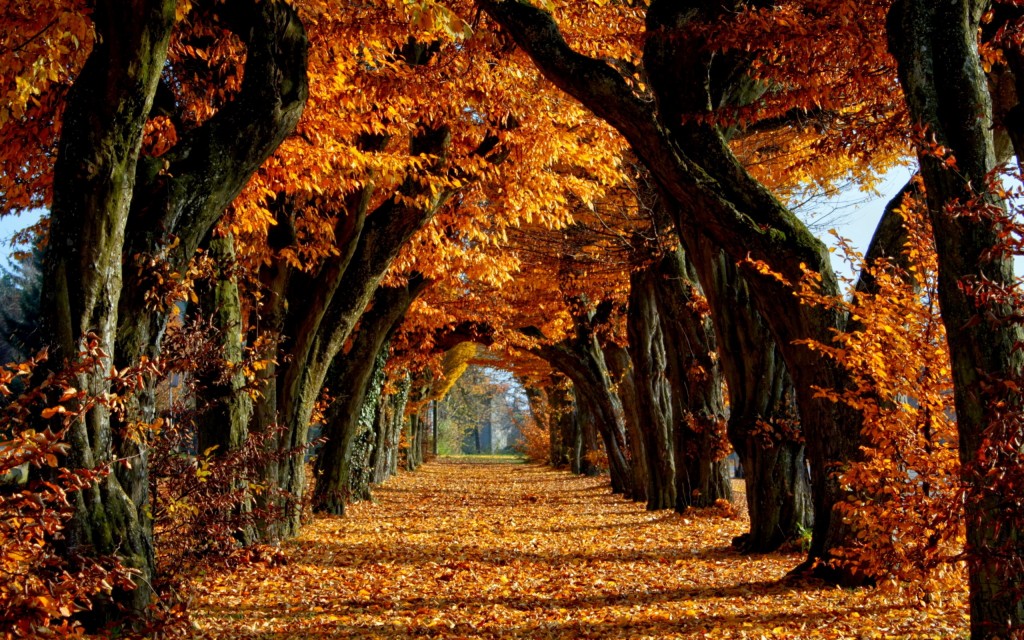The days are getting shorter, we’ve had a few chilly nights and Autumn colour is well and truly bringing our gardens alive. October is the time to get out in the garden and enjoy the last few warm days of Autumn before the start of early frosts in November.
Here are our tips for what to do in the garden in October in preparation for the Winter months ahead.
1. Clear up fallen leaves regularly
Rake up fallen leaves particularly off lawns and around trees and shrubs and turn them into leaf mould ready for next year. If you’re short on space a leaf bag is the perfect way of turning your leaves into a home made mulch or soil conditioner.
To do this simply:
- Take a black bin liner and punch a few holes in the side and bottom.
- Rake up leaves regularly (at least weekly) and add to the bag.
- When almost full, sprinkle with water, shake and tie.
- Store you leaf bag in a shady spot for a year allowing your leaves to rot down into a rich, crumbly mixture that can be used as a mulch around the base of trees and plants.
- If you want to use the leaf mould as a soil conditioner, allow the leaves to rot down for another year.
2. Cut back herbaceous perennials
Keep your garden looking tidy by cutting back hardy perennials that have finished flowering to help improve appearance and flowering, and minimise risk of mould or disease setting in over Winter.
The RHS recommend the following general rules of thumb for pruning perennials in Autumn:
- Use clean, sharp knife, shears or secateurs to cut stems close to the ‘crown’ or dormant base of the plant.
Cut to just above any young growth. - Remove weeds and dig out those with thick or fleshy roots such as dandelions and docks.
- Cut back to soil level perennials that produce leaves and flower stems from below the soil level (e.g. crocosmia and paeonies).
- Perennials showing new basal shoot growth (e.g asters and sedum) can be cut back less severely.
- Keep any attractive dead stems or flower heads to provide over Winter interest and food for wildlife. These can be left until early spring.
- Separate and burn any diseased material (showing signs of leaf-spots, mildew and rusts, for example).
- Compost all other material, excepting ripening seed heads.
- Apply a light mulch and feed in early spring
Tip: Tender perennials, such as penstemons, are left so that the old stems protect the crown from frost. Prune these once the risk of frost has passed in April or May the following year. Leave evergreen perennials such as kniphofia and sedges until next Spring or Summer when you simply need to tidy their foliage by removing dead leaves.
3. Renovate lawns
Remove leaves from the lawn and give it a final cut for the season, not too short now (a minimum of 2 to 3 centimetres). Repair bald patches with a sprinkle of compost and grass seed. Or lay new patches of grass with turf while the weather is still mild and wet.
For lawns in need of a little more tlc, the Thames Valley Landscape team offer a range of lawn care services designed to breath new life into your grassed areas.
4. Trim hedges
Box, yew, privet and hawthorn hedges – if you haven’t yet given them a prune, now is the time for a quick trim to keep them looking neat and tidy over the Winter. This will help retain their form and provide a structure to your garden over the Winter months.
5. Plant now for colourful Spring displays
Plant bulbs now for the first splashes of colour in late Winter and early Spring through to summer. Snowdrops, crocuses and daffodils will give you the early displays, whilst tulips and aliums will see you through to fiery displays of Summer. For the most stunning display, plant your bulbs in clumps of five or seven bulbs of the same variety throughout your borders.
Plant Spring bedding and biennials, such as wall-flowers and foxgloves, for vibrant Spring displays. Mix texture with colour in your pots and hanging baskets, combining Spring bedding plants with bulbs, grasses, dwarf conifers, violas, pansies and cyclamen.
For help or inspiration with creating new borders and planning new planting schemes speak to one of our gardening experts on 01628 629720.
6. Prune climbing roses
Tidy up climbing roses by giving them a last prune before Winter. This pruning will help to lessen congestion and encourage vigorous growth with a beautiful display of flowers each year.
- First remove dead, diseased or dying branches
- Then tie in any new shoots needed to fill supports
- Prune any flowered side shoots back by two thirds of their length
- For heavily congested plants, cut out any really old branches from the base to promote new growth
7. Enjoy the last of the harvest
Collect and store the last of your fruit harvest including grapes, apples, pears, quince and medlars. Turn excess fruit into chutney, juice, jelly or try your hand at cider making.
Harvest pumpkins, ready for carving at Halloween.
8. Check and repair garden structures
Carry out checks of garden structures such as sheds, fencing and ornamental features to make sure they are sound and will withstand Winter weather of snow, ice, rain and winds.
Carry out repairs, or call Thames Valley Landscapes on 01628 629720 for help with carrying out garden maintenance.


